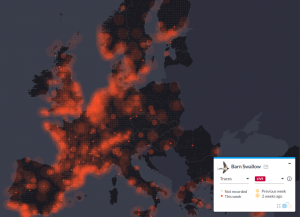EBP
Mobilizing 100,000 volunteer birdwatchers and 30 million new bird records every year to unravel European-wide spatiotemporal patterns of bird distribution.
Visit the project website at www.eurobirdportal.org.

Why such a project?
Unlike more traditional monitoring projects, which focus on structured data collection, online bird portals aim mainly to obtain year-round data from the relatively unstructured but intensive and widespread activities of birdwatchers. However, despite the fact that data are gathered following simple standardised protocols (e.g. complete lists), or in some cases even no protocol (casual observations), the vast amount of data contained in these portals and the sheer amplitude of their combined geographical and taxonomic coverage offer great potential for research on the temporal and spatial distribution of birds across large geographical areas.
To take profit of all these possibilities, the purpose of EBP is to establish a European data repository based on aggregated data from online bird recording portals from across Europe with the following major objectives in mind:
- To describe large scale spatiotemporal patterns of bird distributions (seasonal distributional changes, migratory patterns, phenology) and their changes over time.
- To improve the value of online data gathering portals.
Which is the role of the EBP among the different EBCC initiatives?
The EBP will be the perfect companion to the work developed by the other two main projects undertaken by the EBCC: the Pan-European Common Bird Monitoring Scheme (PECBMS) and the new European Breeding Bird Atlas (EBBA2). PECBMS, a joint initiative with BirdLife International, monitors breeding population trends across Europe, using large-scale and long-term common breeding bird surveys and developing indicators of the general state of nature, while EBBA2 will produce a precise snapshot of the breeding distribution of all European bird species for the whole continent and for a specific time window (2013-2017). The EBP project will complement PECBMS and EBBA2 by focussing on the study of continental-wide seasonal changes in bird distribution as well as those temporal changes taking place too fast as to be properly tracked by more traditional monitoring projects. Moreover, EPB will promote the use of simple, standardized bird recording protocols so as to improve the quality of the results that can be produced using these data.
Organization & geographical coverage
The EBP is developed through a partnership that currently comprises 29 institutions from 21 different European countries.
The partnership involves biodiversity data centers and references ornithological institutions in their respective countries, accumulating a long-time experience collecting high-quality monitoring data from thousands of volunteer birdwatchers and turning this information in sound science. Overall, the online data gathering portals run by the EBP partners collect c. 30 million bird records every year thanks to the collaboration of more than 100,000 active observers. This is the largest and most dynamic citizen science biodiversity data flow in Europe.
The EBP demo viewer
The EBP demo viewer aims to show the scope and potential of the EBP project and its future developments. It is, therefore, solely a very first insight into the possibilities of the collaborative work of European on-line bird recording schemes under the auspices of the EBCC.
The demo viewer, launched during the last Green Week (June 2015), shows a set of five different animated maps depicting the week by week distributional patterns of 15 species in four years (2010-2013) at a resolution of 30×30 km. Moreover, temperature and precipitation maps are also shown for comparative purposes. Two animated maps of any species or climatic variable, year, and type can be selected to be shown simultaneously for direct comparison. During the next months, the list of available species will progressively increase to 50, and data from 2014 will also be added, offering more than 1.5 million different map combinations to choose from.
For further information, please contact:
Gabriel Gargallo, EBP Project Coordination, anella @ ornitologia.org
Visit www.eurobirdportal.org for more detailed information and all relevant documentation.